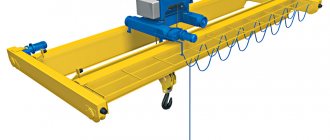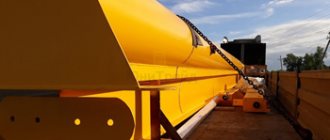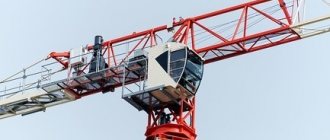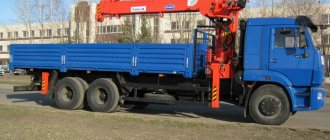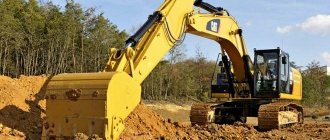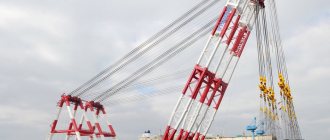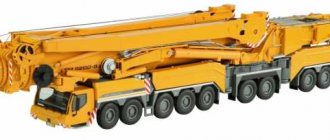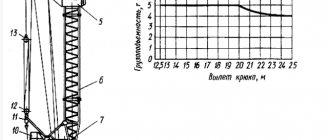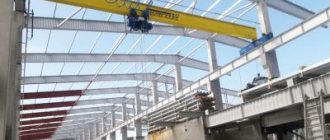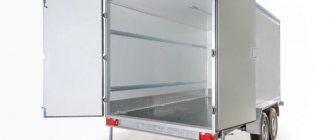The Veris group of companies offers the manufacture of beam cranes according to your individual order.
We manufacture overhead cranes (beam cranes) with a lifting capacity of up to 10 tons inclusive. We make bridges of a box-shaped design, because this type is most resistant not only to vertical, but also to lateral loads.
We are waiting for your calls at +7 (4012) 507-937 and emails at [email protected] for consultation with our specialists.
Types and device
Based on their design features, there are two types of beam cranes:
- supporting;
- hanging.
They are widely used in the construction and installation industry, warehouses of various profiles, and at car repair enterprises. Depending on the technical characteristics, this type of lifting transport is produced in different modifications.
Suspended beam crane 5 t - this type is used only in closed hangars or workshops. The running wheels of the transport move along the trusses of the production premises or I-beams mounted on supports. The movement distance of the cargo device is limited by limit switches installed at the ends of the trolley track. The structure consists of a single-span beam, a lifting mechanism, a remote control panel, and a running carriage.
Features of overhead crane beam
Support crane beam - this type is a structure, the basis of which is a span beam, equipped with a load carriage with the necessary components. Movement is carried out along the span on rails mounted along the entire length of the room. Trolleys are laid parallel to the rail tracks, through which power supply is supplied to the structural units of the supporting crane beam. Like the previous model, limit switches serve as movement limiters.
Features of the support crane beam
Support crane beam
Crane beams are classified into suspended and supporting. The support crane-beam includes a span (bearing) beam and an electric hoist (telpher) moving along it, a control panel and a number of auxiliary devices (various grips for lifting loads, a load limiter, etc.) At both ends of the span beam there are special “end” beams used to move the hoist along crane tracks. A beam crane of this class is driven by an electric or manual drive.
The crane can be controlled either directly from the cabin or from outside, using a specialized push-button station. The main area of its use is low-intensity loading and unloading operations in warehouses and industrial workshops.
Main technical parameters
The popularity of the 5 t beam crane is explained by the optimal combination of compact size with speed, tonnage of transported cargo, and ease of use.
Main technical parameters of the standard model of 5 t overhead crane:
| Span used | up to 25 meters |
| Full length of crane | up to 27.9 meters |
| Travel speed | 0.5 m/s |
| Lifting speed | 0.13 m/s |
| Lifting height | up to 18 meters |
| Crane weight | up to 2.8 tons |
| Console length | up to 1.2 meters |
| Electric motor power | 4x0.37 kW |
The 5 t support type beam crane as standard has the following main technical parameters.
| Span used | up to 16.5 meters |
| Crane weight | up to 3.27 tons |
| Load lifting height | up to 6 m |
| Lifting speed | 0.13 m/s |
| Travel speed | 0.33 m/s |
Any type of overhead crane operates from a three-phase current source with a voltage of 380 V. Its use is characterized by relatively low energy consumption. A flexible cable is used to supply electricity. Modern models operate in a wide temperature range: from –20 to +40ºС. The device is equipped with a remote control panel, from which commands are issued to move the mechanism components.
Crane beam device
Overhead crane
A beam crane of this type is structurally representative of an overhead crane, with running wheels of end beams resting on I-beams - crane rails. I-beams are installed in the ceilings of rooms in which loading and unloading or lifting and transport operations are carried out. Such equipment includes a span beam, a lifting mechanism (telpher or hoist), a control panel, a running carriage and auxiliary devices. The crane beam is usually controlled from below using a push-button station.
The main areas of its use are the maintenance of large-scale energy and metallurgical equipment, and in addition, the lifting of large and medium-sized cargo on crane racks.
Installation Features
For the installation of the crane beam, various technological methods are provided, depending on its type. When installing a 5-ton support crane beam, the end beams are mounted to the crane tracks. At the next stage, the span of the mechanism rises upward. Finally, the support model is installed and the end and load-bearing parts of the equipment are secured.
Crane beam installation
Assembly of the suspension mechanism begins at the bottom. The carrier and end beams are first connected. The completed equipment is lifted to the required distance and mounted on prepared crane tracks. For safe operation of the lifting equipment, it is necessary to strengthen the ceilings and install additional supports.
To select the required standard size of a 5 t beam crane, you should evaluate the available span width of the room, the required minimum and maximum load capacity. Additional criteria may be the speed of movement of the equipment and the height of the load. If it is necessary to work on open overpasses, additional protection of electrical components from external influences is provided.
Related video: Crane beam
Publications on the topic
Overview of technical characteristics of the 5 t beam crane
Advantages and features of using wooden I-beams
How to install a hip roof with your own hands
General device
A beam crane differs from an overhead crane in that it has only one main beam part. It consists of:
- lifting device;
- end beams.
span beam - the trajectory of its movement;
The work cycle consists of several operations:
- lifting the load to a given height;
- its horizontal movement to the place of installation work or laying;
- unloading materials;
- returning to the starting position.
Crane devices with telescopic boom
When unloading covered cars at railway stations, it is most convenient to use beam cranes with a telescopic boom. They consist of:
- from a crane bridge;
- telescopic beam;
- support rollers;
- devices for extending the telescopic boom;
- hook, which is mounted on hinges capable of rotating in all planes.
To ensure that the extension of the boom does not disturb its support base, the drive with rollers is mounted on an intermediate beam. It is known that telescopic forklifts with inclined crane beams are indispensable in warehouses, railway stations, and ports. Telescopic crane beams, capable of changing the angle of inclination in the range of 0-30 degrees, have become especially popular.
Telescopic loaders are presented on the market in three modifications. They can simultaneously combine three beam cranes. Telescopic forklifts are equipped with a comfortable cabin and a safety system. Some models are capable of lifting loads to a height of up to 18 m. Telescopic loaders are multifunctional; they can be equipped with various attachments - buckets, loading platforms.
Types of equipment
Today, the crane beam market offers two types of such equipment, which have minor differences:
- support crane beam;
- suspended crane beam.
In the first type of model, special rails are used to move the end beams along the crane runway, along which their running wheels move. The support crane can be controlled manually or electrically. They are typically used for warehouse handling or industrial workshops.
In a suspended structure, crane tracks do not require additional supports; they are installed in the ceiling, which saves installation time. Suspended crane beams are moved using a control panel. They are convenient for servicing large materials and industrial equipment. Their main advantage is the expanded work space. In addition, with the same load capacity, they are much lighter.
For large working areas, a successful design solution was the use of suspended two-span crane beams. They differ from standard ones only in the length of the bridge. By increasing its length, the service area is significantly expanded. To reduce the excess load on the bridge and prevent its deformation, another I-beam track is mounted to the floors as an additional supporting element.
Types of drives
The crane design uses two types of drives.
Manual is cheaper and easier to operate. It is usually installed when lifting small masses and dimensions, and provides a low speed of movement of the hoist compared to an electric one.
The manual mechanism is used less and less; it gives low productivity, as it is driven by the worker’s muscle power. It operates using a shaft connected to running wheels and is more often used in small repair shops or artisanal workshops and warehouses. Manually driven beam cranes have the following characteristics: lifting capacity – up to 10 tons; span – 20 t.
Undoubtedly, the electric drive has higher performance characteristics; it also has the greatest application. The movement of cargo in it is ensured by an electric motor, a gearbox and a transmission shaft, which transmits rotation via gears to the wheels of the cargo trolley. The electric drive is designed for high performance:
- significant carrying capacity;
- intensive use of crane equipment;
- high labor productivity.
Necessary conditions for installing a crane
Before you begin installing the crane beam, you should make sure that the building can withstand the loads that arise during operation. The assembly process is carried out in several stages:
- delivery of all mechanisms to the assembly site;
- installation of the unit on crane tracks;
- lifting and installation of the bridge;
- final installation steps.
Before installing the crane, the following preliminary work should be done:
- complete the installation of metal structures for at least 5-6 spans;
- install and check crane tracks;
- make sure there is a railway track on the site;
- calculate the length of the installation area - it should be twice as long as the bridge.
After receiving the certificate of completion of the preparatory work, installation of the installation can begin.
Affordable prices, ease of assembly, and good performance indicators have ensured that the beam crane is highly popular among customers. They often act as the only possible option for carrying out lifting work in hard-to-reach places.
Motors with wound and squirrel-cage rotor
Units of this type are asynchronous motors in which the winding rotor is connected to the working and transmission elements through slip rings. The motor torque and speed are controlled by external resistance.
To start the rotor unit, a low starting current and a high resistance installed in the rotor circuit are used. During further acceleration, the resistance is reduced if necessary. The winding of a wound-rotor motor differs from a squirrel-cage motor in the large number of turns. Another difference is the increased induced voltage and lower available voltage.
A standard rotor starts with three poles connected to slip rings. In this case, a series connection is made between each pole and the variable power resistor. Reducing the stator field strength can be done by starting this resistor, resulting in a decrease in starting current. In addition, electric motors with wound rotor are characterized by high starting torque.
A crane unit with a squirrel-cage rotor also belongs to asynchronous motors. Its design includes a steel cylinder, on the surface of which copper or aluminum conductors and a rotating rotor are located in grooves. A special alloy steel is used to make the rotor core.
Metal faucet components
The supporting structures of the crane - span and end beams - have the highest metal consumption, which affects its weight. The main beam is usually rectangular in shape, welded from steel parts or lattice trusses to increase load resistance.
To ensure strength, diaphragms with stiffeners are inserted inside the beam. The main beam and end beams are connected by welding or using bolts. The second method eliminates the possibility of deformation and guarantees quick and accurate installation of the crane.
The weight of the outer, auxiliary wall of the bridge is reduced due to cutouts in the metal sheets, without reducing its load-bearing characteristics. The main beam may experience bending deformations from constantly moving loads. To prevent its deformation, the beams are given a construction lift in advance, that is, when cutting the steel sheets, they are slightly bent upward.
The end beams, which have a rectangular shape, have limiters. If the crane is used in an open area, additional anti-theft devices are installed to protect against wind.
What are the differences between crane engines?
An electric motor intended for crane equipment is usually produced in a closed version. The resistance class of insulating materials to high temperatures corresponds to F and H.
The technical characteristics of these units are characterized by a minimum moment of inertia of the rotor and a low rotation speed. This allows you to significantly reduce energy losses during transient processes. High resistance to overloads is ensured by a large magnetic flux.
There are indicators for the values of short-term torque overloads, which in hourly mode range from 2.3 to 3.5 for AC motors, and 2.15-5.0 for DC units. The maximum permissible operating speed correlates with the nominal speed by a factor of 3.5-4.9 for direct current and 2.5 for alternating current.

